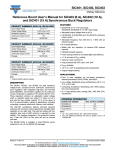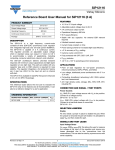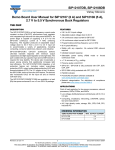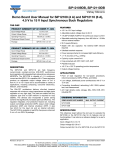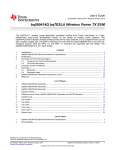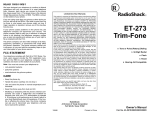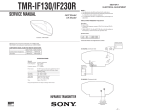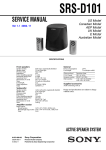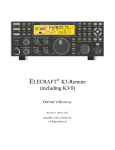Download SiC401DB, SiC402DB, SiC403DB Reference Board User`s Manual
Transcript
SiC401DB, SiC402DB, SiC403DB www.vishay.com Vishay Siliconix Reference Board User's Manual THE CHIP PRODUCT SUMMARY SiC401A/B Input Voltage Range 3 V to 17 V Output Voltage Range 0.6 V to 5.5 V Operating Frequency 200 kHz to 1 MHz Continuous Output Current Peak Efficiency Package 15 A 95 % PowerPAK MLP55-32L FEATURES • SiC401 provides 15 A continuous output current capability • SiC402 provides 10 A continuous output current capability • SiC403 provides 6 A continuous output current capability • Light Load Power Save Operation - SiC401A, SiC402A and SiC403A: minimum operating frequency fixed at 25 kHz - SiC401B, SiC402B and SiC403B: no minimum operating frequency PRODUCT SUMMARY SiC402A/B • Integrated bootstrap switch Input Voltage Range • Programmable 200 mA LDO with bypass logic 3 V to 28 V Output Voltage Range 0.6 V to 5.5 V Operating Frequency 200 kHz to 1 MHz • Temperature compensated current limit • Pseudo fixed-frequency adaptive on-time control Continuous Output Current 10 A • All ceramic solution enabled Peak Efficiency 95 % • Programmable input UVLO threshold Package PowerPAK MLP55-32L PRODUCT SUMMARY SiC403A/B Input Voltage Range 3 V to 28 V Output Voltage Range 0.6 V to 5.5 V Operating Frequency 200 kHz to 1 MHz Continuous Output Current Peak Efficiency Package 6A 95 % PowerPAK MLP55-32L • Independent enable pin for switcher and LDO • Programmable soft-start and soft-shutdown • 1 % internal reference voltage • Power good output • Over-voltage and under-voltage protections • PowerCAD simulation software available at www.vishay.transim.com/login.aspx • Material categorization: For definitions of compliance please see www.vishay.com/doc?99912 DESCRIPTION APPLICATIONS The Vishay Siliconix SiC401A/B, SiC402A/B and SiC403A/B are advanced stand-alone synchronous buck regulators, featuring integrated power MOSFETs, bootstrap switch, and a programmable LDO in a space-saving PowerPAK MLP55-32L pin packages. • Notebook, desktop and server computers The SiC401A/B, SiC402A/B and SiC403A/B are capable of operating with all ceramic solutions and switching frequencies up to 1 MHz. The programmable frequency, synchronous operation and selectable power-save feature allow operation at high efficiency across the full range of load current. • Embedded applications The internal LDO may be used to supply 5 V for the gate drive circuits or it may be bypassed with an external 5 V for optimum efficiency and used to drive external n-channel MOSFETs or other loads. Additional features include cycle-by-cycle current limit, voltage soft-start, under-voltage protection, programmable over-current protection, soft shutdown and selectable power-save. Both the SiC401A/B, SiC402A/B and SiC403A/B provides an enable input and a power good output. Revision: 22-Jan-14 • Digital HDTV and digital consumer applications • Networking and telecommunication equipment • Printers, DSL, and STB applications • Point of load power supplies ORDERING INFORMATION DEMO BOARD PART NUMBER MAX. OUTPUT CURRENT SiC403DB 6A SiC402DB 10 A SiC401DB 15 A Document Number: 62923 1 For technical questions, contact: [email protected] THIS DOCUMENT IS SUBJECT TO CHANGE WITHOUT NOTICE. THE PRODUCTS DESCRIBED HEREIN AND THIS DOCUMENT ARE SUBJECT TO SPECIFIC DISCLAIMERS, SET FORTH AT www.vishay.com/doc?91000 SiC401DB, SiC402DB, SiC403DB www.vishay.com Vishay Siliconix THE REFERENCE BOARD Input voltage (VDC): 3 V to 17 V for SiC401A/B or 3 V to 25 V for SiC402A/B or 3 V to 25 V for SiC403A/B Due to the nature of this controller, which requires a minimum amount of ripple of 20 mVpp to operate properly, if an all ceramic output solution is required, an additional ripple injection circuit (R9, C19 and C24) must be used. This will "artificially" generate ripple and apply it directly to the FB pin while the output ripple is very low. More detail can be found in the datasheet and in the output voltage ripple section below. Output voltage (VDC): 0.6 V to 5.5 V CONNECTION AND SIGNAL/TEST POINTS Output current (A): 15 A for SiC401A/B or 10 A for SiC402A/B or 6 A for SiC403A/B Power sockets This reference board allows the end user to evaluate the SiC401A/B, SiC402A/B and SiC403A/B for its features and all functionalities. It can also be a reference design for a user's application. SPECIFICATION Notes • This board is, by default, preset to 1.2 V output with 12 V input (Note: for inputs lower than 12 V, see “Input Voltage Range Adjustment” (page 5)) • This board can be set to any output voltage between 0.6 V and 5.5 V, and any input voltage between 6 V and 28 V. For a specific input/output voltage combination, the values of inductor and ripple injection circuit may need to be modified.. • Since the internal LDO is set to 5 V, it is used to drive the VDD input on the reference board. Input voltages lower then 5 V require an external 5 V supply and should be connected to VDD to bias the internal drivers and logic. Since an external source is used, the internal LDO should be disabled by removing R6. Efficiency is expected to be improved since the internal LDO is not used. INPUT CAPACITORS The input capacitors are chosen as a combination of electrolytic and ceramics so that the capacitance, the RMS current, the ESR, the input voltage ripple and the cost can be all fairly satisfied. For a combination of high voltage input and low voltage output (low duty cycle), the electrolytic capacitor (C12) may not be required. The reference board uses 25 V input ceramics therefore, please limit Vin to 25 V or less. INDUCTORS If off-the-shelf inductors are to be used, then their DCR and saturation current parameters are key besides the inductance values. The DCR causes an I2R loss, which will decrease the system efficiency and generate heat. The saturation current has to be higher than the maximum output current plus 1/2 the ripple current. In over current condition the inductor current may be very high. All this needs to be considered when selecting the inductor. On this board Vishay IHLP4040DZ or IHLP5050 series inductors are used to meet cost requirement and get better efficiency. OUTPUT CAPACITORS Voltage, ESR and RMS current capability and capacitance are essential elements to consider when choosing output capacitors. The ESR and capacitance affect the output voltage ripple, transient response and system stability. The current capability determines the capacitor power dissipation and life time. To meet all of these 4 requirements, a combination of ceramics and tantalums can be used. Revision: 22-Jan-14 VIN (B1), VIN_GND (B2): Input voltage source with VIN to be positive. Connect to a 12 V to 25 V source that powers SiC40xCD. VO (B3), VO_GND (B4): Output voltage with VOUT to be positive. Connect to a load that draws less than 15 A current. Signal and test leads VIN (P8), VIN_GND (P9): Input voltage sense pins with VIN to be positive. An oscilloscope or Volt meter can be connected to these terminals to measure or observe the input. VO (P10), VOUT_GND (P11): Output voltage sense pins with VO to be positive. An oscilloscope or Volt meter can be connected to these terminals to measure or observe the output. VCTRL (P5), LDTRG (P4), VO_GND (P11): Load step control signal input. Connect VCTRL and GND to a power source, which supplies the correct voltage to generate the needed load step. Connect LDTRG and GND to a pulse generater that drives the MOSFET which is used for transient testing. EN/PSV (P2): This pin on the SiC401A/B, SiC402A/B and SiC403A/B have three functions: continuous run is enabled by floating this pin, HI enables power save (PSV) and grounding this pin disables switching. Continuous run mode has poor light load efficiency which is typical in traditional fixed frequency switchers. By enabling PSV light load, efficiency is greatly improved. Connecting a jumper from VDD (P1) to EN/PSV (P2) will pull this pin HI and PSV is enabled. Tying this pin to ground disables switching. ENL (P6): This pin is pulled up to VIN through a 100K resistor and enables the internal adjustable LDO. An external power source may be used by removing R6 and applying +5 V to P1. The IC has an internal switchover circuit which improves efficiency by tying VOUT to VLDO if VOUT is within ~ 0.5 V of VLDO and disables the internal LDO. The default setting is LDO enabled and VLDO is set to 5 V. Detailed description can be found in the datasheet. PGOOD (P7): This is an open drain output and is pulled up with a 10K resistor. When the voltage at the FB pin is 10 % below the nominal voltage, PGOOD is pulled low. It is held low until the output voltage returns above -8 % of nominal. PGOOD will transition low if the VFB pin exceeds +20 % of nominal, which is also the over-voltage shutdown threshold. PGOOD also pulls low if the EN/PSV pin is low when VDD is present. Document Number: 62923 2 For technical questions, contact: [email protected] THIS DOCUMENT IS SUBJECT TO CHANGE WITHOUT NOTICE. THE PRODUCTS DESCRIBED HEREIN AND THIS DOCUMENT ARE SUBJECT TO SPECIFIC DISCLAIMERS, SET FORTH AT www.vishay.com/doc?91000 SiC401DB, SiC402DB, SiC403DB www.vishay.com Vishay Siliconix SET UP LOAD STEP The hardware to test transient response is included in the board, which allows users to see how the transient response performs. The setup steps are: 1. Decide what load step is wanted, then based on the output voltage calculate the external voltage VEXT that will be connected between VCTRL and GND. For example, a load step of 5 A between 0 A (I1) and 5 A (I2) is required and the output voltage is 1.2 V. VEXT = VO - (I2 - I1) * 1 = 1.2 - (5 A - 0 A) * 1 = -3.8 V. Preset a DC source voltage to VEXT = 3.8 V (current capability around 2 A) and connect it to the board with positive side to GND and negative side to VCTRL (if VEXT is a positive value, then connect the DC source positive to VCTRL and negative to GND). (Note: R4 need to change to 0.5 for the transient load step test if the step output current is more than 7.5 A.) 2. Preset a waveform from a function generator using the following parameters and set its output to OFF (refer to the specific function generator manual for its setup): Shape: Pulse Frequency: 50 Hz or whatever is required Duty cycle: ~ 0.1 % or whatever is required (keep duration small so load step resistor will not be damaged) Amplitude: +10 V level Rising time and falling time: 1 μs or whatever is required. 3. Connect the function generator output positive to LDTRG and negative to GND. 4. Preset the current of an electronic load to I1 and turn it on. 5. Set up an oscilloscope using the following parameters. Channel 1 for probing output voltage: AC coupled, 50 mV/div or whatever is required. Channel 2 for probling the current on the 1 resistor (R4) (use differential probe): DC coupled, 1 V/div (corresponds to 1 A/div), for the step load current more than 7.5 A, please use 0.5 resistor for R4. 1 V/div is corresponds to 2 A/div. To view the output choke current, a simpler method is to install a current loop using 18AWG wire after the inductor and using a current probe. Lift the side of the inductor connected to the output caps and solder the loop of wire from the inductor to where it was connected on the board. Keep the loop of wire just big enough for the probe to fit. This will have a slight delay in the waveform compared to the output voltage, but is really used to varify the load step amplitude is correct. Time base: ~ 2 ms/div Bandwidth: 20 MHz 6. Connect oscilloscope channel 1 probe positive to VO (P10) and negative to VO_GND (P11), and channel 2 probe positive to VO (P10) and negative to Step_I_SENSE (P3). 7. Turn on the system power. Output voltage should be shown on the electronic load with current of I1. 8. Turn on the power source for VEXT. 9. Set the function generator output to be ON. The transient response waveforms should be seen on the oscilloscope. 10. If needed, re-adjust the trigger waveform’s rising and falling time on the function generator so that the current slew rate is satisfied (the current slew rate can be seen on oscilloscope channel 2 waveform by setting the time base to 1 μs or 500 ns). 11. To change load step, decrease or increase the value of VEXT. 12. To cease transient response test, simply set the function generator output to off, turn off the power source for VEXT, and then shut down the system power. Fig. 1 - SiC401A Transient Step Load Response in Forced Continuous Mode Revision: 22-Jan-14 Document Number: 62923 3 For technical questions, contact: [email protected] THIS DOCUMENT IS SUBJECT TO CHANGE WITHOUT NOTICE. THE PRODUCTS DESCRIBED HEREIN AND THIS DOCUMENT ARE SUBJECT TO SPECIFIC DISCLAIMERS, SET FORTH AT www.vishay.com/doc?91000 SiC401DB, SiC402DB, SiC403DB www.vishay.com Vishay Siliconix Fig. 2 - SiC401A Transient Step Load Response in Power Saving Mode Efficiency (%) 90 85 80 75 70 65 60 55 50 45 40 35 30 25 20 Efficiency in FCM 0 2 4 6 Efficiency in PSV 8 10 Output Current (A) 12 14 16 14 16 Fig. 3 - SiC401A Efficiency 0.8 0.6 Load Regulaon (%) Load Regulaon in FCM Load Regulaon in PSV 0.4 0.2 0 -0.2 -0.4 -0.6 0 2 4 6 8 10 12 Output Current (A) Fig. 4 - SiC401A Load Regulation Revision: 22-Jan-14 Document Number: 62923 4 For technical questions, contact: [email protected] THIS DOCUMENT IS SUBJECT TO CHANGE WITHOUT NOTICE. THE PRODUCTS DESCRIBED HEREIN AND THIS DOCUMENT ARE SUBJECT TO SPECIFIC DISCLAIMERS, SET FORTH AT www.vishay.com/doc?91000 SiC401DB, SiC402DB, SiC403DB www.vishay.com OUTPUT VOLTAGE ADJUSTMENT The evaluation board is configured for a 1.2 V output. If a different output voltage is needed, simply change the value of R23 based on the following formula: Vishay Siliconix Decreasing R9 will allow more signal through, hence more ripple will be seen at the FB pin. Be sure to check that the signal from the virtual ESR circuit is in phase with the output ripple. C24 is a 0.1 μF capacitor. VO = 0.6 * (1 + R10/R23) + Vripple/2 Where: R10 is the upper resistor of the feedback voltage divider R23 is the lower resistor of the feedback voltage divider Vripple is the output ripple voltage. See the following demo board schematic for R10 and R23. INPUT VOLTAGE RANGE ADJUSTMENT The input voltage range for this demo board is from 12 V to 25 V because a input power UVLO circuit is designed in to protect the demo board. For the user who wants to explorer the operation of the demo board in the lower input voltage, he can remove the R52 to disable the input power UVLO function of the demo board. OUTPUT RIPPLE VOLTAGE The controller used in the SiC40x requires at least of 20 mV of ripple at the FB pin of the IC. This is easily attainable when using a combination of output capacitors with higher ESR like Electrolytic or Tantalum in parallel with low ESR ceramic. The rule of thumb used for setting a limit for output ripple voltage is a nominal 3 % of the output voltage. Using this as a representative value and choosing a ripple current (•I) that is between 20 % to 40 % of full load current we can now calculate for an inductor value. By measuring the actual ripple voltage using the values calculated so far and adjusting one or more of the following: the inductor value, number of output caps and Fsw used would lock in the final values chosen for the design. ESR = (0.03 * VOUT) / (0.4 * IOUTmax.) using 40 % for the ripple current Fig. 5 - Ripple Voltage Injection Circuit Before adding a ripple injection circuit, the ripple voltage in the feedback of the device need to be determined first to make sure the ripple voltage is lower than 20 mV. The ripple injection circuit is required only when the ripple voltage in the feedback is lower than 20 mV. There may be difficulty measuring the ripple voltage of feedback pin on the demo board. However, it is recommended to measure the ripple voltage on the output voltage VO. The ripple voltage on the feedback can be easily calculated from the output ripple voltage by the following formula. VFB_ripple/Vripple = R23/ (R10 + R23) Where: VFB_ripple is the ripple voltage on the feedback. Vripple is the output ripple voltage. R10 is the upper resistor of the feedback voltage divider. R23 is the lower resistor of the feedback voltage divider. L = [(VIN - VOUT) * (VOUT/(Fsw * VIN))] / [0.4 * (IOUTmax.)] When an all ceramic output capacitor is used which limits the amount of ripple voltage because of the very low ESR an additional ripple voltage injection circuit consisting of 3 inexpensive passive components (R9, C19 and C24) is needed. The network is a series RC connected across the output inductor and a cap which couples this signal to the FB pin. The objective is to stabilize the IC by increasing the ripple at the FB pin by summing the ripple generated by this ESR circuit with the low ripple generated by the ceramic output capacitors. Using the following formula and the circuit below we can get approximate values. For example, L1 = 1 μH, DCR of inductor = 3.5 m, Let R1 = 3K solving for C1 we get L1/DCR = R9 * C19 C19 = (1 μH/3.5 m)/3K = 95 nF = 0.1 μF Revision: 22-Jan-14 Document Number: 62923 5 For technical questions, contact: [email protected] THIS DOCUMENT IS SUBJECT TO CHANGE WITHOUT NOTICE. THE PRODUCTS DESCRIBED HEREIN AND THIS DOCUMENT ARE SUBJECT TO SPECIFIC DISCLAIMERS, SET FORTH AT www.vishay.com/doc?91000 SiC401DB, SiC402DB, SiC403DB www.vishay.com Vishay Siliconix SCHEMATIC OF DEMO BOARD Revision: 22-Jan-14 Document Number: 62923 6 For technical questions, contact: [email protected] THIS DOCUMENT IS SUBJECT TO CHANGE WITHOUT NOTICE. THE PRODUCTS DESCRIBED HEREIN AND THIS DOCUMENT ARE SUBJECT TO SPECIFIC DISCLAIMERS, SET FORTH AT www.vishay.com/doc?91000 SiC401DB, SiC402DB, SiC403DB www.vishay.com Vishay Siliconix BILL of MATERIAL for SiC401A ITEM QTY 1 4 2 3 REFERENCE PCB VALUE VOLTAGE FOOTPRINT DESCRIPTION PART NUMBER C1, C2, C3, C4 SM1210 22 μF 16 V CAP, 22 μF, 16 V, 1210 GRM32ER71C226ME18L 1 C5 SM0402 0.1 μF 10 V CAP, 0.1 μF, 10 V, 0402 VJ0402Y104MXQCW1BC 4 C6, C7, C11, C14 SM0603 0.1 μF 50 V CAP, 0.1 μF, 50 V, 0603 VJ0603Y104KXACW1BC 4 3 C10, C20, C22 593D 68 μF 20 V 68 μF, TAN, 20 V, 593D, 20 % 593D686X0020D2TE3 5 1 C12 Radial 150 μF 35 V Cap, Radial, 150 μF, 35 V EU-FM1V151 6 1 C13 SM0402 0.01 μF 50 V CAP, 0.01 μF, 50 V, 0402 VJ0402Y103KXACW1BC 7 4 C15, C21, C18A, C18B for SiC401 SM1812 100 μF 10 V CAP CER 100 μF, 10 V, 20 %, X5R, 1206 C3216X5R1A107M160AC 8 1 C30 SM0402 68 pF 50 V CAP, 68 pF, 50 V, 0402 VJ0402Y680KXACW1BC 9 1 C26 SM0805 4.7 μF 10 V 4.7 μF, 10 V, 0805 LMK212B7475KG-T 10 1 C28 SM0402 0.1 μF 10 V CAP, 0.1 μF, 10 V, 0402 VJ0402Y104MXQCW1BC 11 1 C29 SM0603 22 nF 25 V CAP,CER 22 nF, 25 V VJ0603Y223KXACW1BC 12 1 C36 SM0402 560 pF 50 V CAP, 560 pF, 0402 VJ0402A561KXAPW1BC 13 1 C37 SM0402 10 nF 50 V CAP, 10 nF, 50 V, 0402 VJ0402A103KXACW1BC, GRM155R71H103KA88D 14 1 L1 for SiC401 IHLP4040 0.56 μH 0.56 μH IHLP4040DZERR56M01 15 11 P1, P2, P3, P4, P5, P6, P7, P8, P9, P10, P11 Terminal 0 0 Test points 1573-3 16 1 Q1 SO-8 0 30 V N-Channel 30 V (D-S) MOSFET with Schottky Diode 0 17 1 R1 SM0603 300K 50 V RES, 300K , 1/10 W, 5 % CRCW0603300KJNEA 18 1 R2 SM0603 100K 50 V RES, 100K, 0603 CRCW0603100KFKEA 19 1 R4 SM2512 1 200 V 1 , 2512 CRCW25121R00FKEG 20 2 R5, R6 SM0603 100K 50 V RES, 100K, 0603 CRCW0603100KFKEA 21 1 R7 SM0603 0 50 V RES 0 CRCW06030000ZOEA 22 1 R8 SM0603 12.4K 50 V RES, 12.4K, 0603 CRCW060312K4FKEA 23 1 R10 SM0603 5.11K 50 V RES, 5.11K, 0603 CRCW06035K11FKEA 24 1 R29 SM0603 10K 50 V RES, 10K , 50 V ,0603 CRCW060310KFKED 25 1 R12 SM0603 57.6K 50 V RES, 57.6K, 0603 CRCW060357K6FKEA 26 1 R13 SM0402 100 50 V 100R, 50 V, 0402 CRCW0402100RFKED 27 1 R14 SM0402 100 50 V 100R, 50 V, 0402 CRCW0402100RFKED 28 1 R15 SM0603 10K 50 V RES, 10K, 50 V, 0603 CRCW060310KFKED 29 1 R23 SM0603 5.11K 50 V RES, 5.11K, 0603 CRCW06035K11FKEA 30 1 R30 SM0603 69.8K 50 V RES, 69.8K, 0603 CRCW060369K8FKEA 31 1 R39 SM0402 0 50 V 0R, 50 V, 0402 CRCW04020000ZOED 32 1 R51 SM0805 3.3R 50 V RES, 3.3R, 0805 CRCW08053R3FKEA 33 1 R52 SM0603 31.6K 50 V RES, 31.6K, 50 V, 0603 CRCW060331K6FKEA 34 1 U1 MLP55-32L 0 0 SiC401B MicroBuck Regulator 0 35 4 B1, B2, B3, B4 0 0 0 BANANA JACK 575-4 36 1 R9 for SiC401 SM0603 33.2K RES, 33.2K 1/10W, 1 %, 0603 SMD CRCW060333K2FKEA 37 1 C24 SM0603 820 pF CAP, CER, 820 pF, 50 V, 5 %, NP0, 0603 C1608C0G1H821J080AA 38 1 C19 SM0603 10 nF CAP, CER, 10 000 pF, 10 V, 10 %, X5R, 0201 C0603X5R1A103K030BA 39 1 PCB Revision: 22-Jan-14 SiC401/2/3 Demo Board PCB Document Number: 62923 7 For technical questions, contact: [email protected] THIS DOCUMENT IS SUBJECT TO CHANGE WITHOUT NOTICE. THE PRODUCTS DESCRIBED HEREIN AND THIS DOCUMENT ARE SUBJECT TO SPECIFIC DISCLAIMERS, SET FORTH AT www.vishay.com/doc?91000 SiC401DB, SiC402DB, SiC403DB www.vishay.com Vishay Siliconix BILL of MATERIAL for SiC402A ITEM QTY REFERENCE PCB VALUE VOLTAGE FOOTPRINT DESCRIPTION PART NUMBER 1 4 C1, C2, C3, C4 SM1210 22 μF 16 V CAP, 22 μF, 16 V, 1210 GRM32ER71C226ME18L 2 1 C5 SM0402 0.1 μF 10 V CAP, 0.1 μF, 10 V, 0402 VJ0402Y104MXQCW1BC 3 4 C6, C7, C11, C14 SM0603 0.1 μF 50 V CAP, 0.1 μF, 50 V, 0603 VJ0603Y104KXACW1BC 4 3 C10, C20, C22 593D 68 μF 20 V 68 μF, TAN, 20 V, 593D, 20 % 593D686X0020D2TE3 5 1 C12 Radial 150 μF 35 V CAP, Radial, 150 μF, 35 V EU-FM1V151 6 1 C13 SM0402 0.01 μF 50 V CAP, 0.01 μF, 50 V, 0402 VJ0402Y103KXACW1BC 7 3 C15, C21, C18 for SiC402 SM1206 100 μF 10 V CAP, CER, 100 μF, 10 V, 20 %, X5R, 1206 C3216X5R1A107M160AC 8 1 C30 SM0402 68 pF 50 V CAP, 68 pF, 50 V, 0402 VJ0402Y680KXACW1BC 9 1 C26 SM0805 4.7 μF 10 V 4.7 μF, 10 V, 0805 LMK212B7475KG-T 10 1 C28 SM0402 0.1 μF 10 V CAP, 0.1 μF, 10 V, 0402 VJ0402Y104MXQCW1BC 11 1 C29 SM0603 22 nF 25 V CAP, CER, 22 nF, 25 V VJ0603Y223KXACW1BC 12 1 C36 SM0402 560 pF 50 V CAP, 560 pF, 0402 VJ0402A561KXAPW1BC C37 SM0402 10 nF 50 V CAP, 10 nF, 50 V, 0402 VJ0402A103KXACW1BC, GRM155R71H103KA88D 1 L1 IHLP4040 1 μH 0 1 μH IHLP4040DZER1R0M01 15 11 P1, P2, P3, P4, P5, P6, P7, P8, P9, P10, P11 Terminal 0 0 Test points 1573-3 16 1 Q1 SO-8 0 30 V N-Channel 30 V (D-S) MOSFET with Schottky Diode 0 17 1 R1 SM0603 300K 50 V RES 300K , 1/10 W, 5 % CRCW0603300KJNEA 18 1 R2 SM0603 100K 50 V RES, 100K, 0603 CRCW0603100KFKEA 19 1 R4 SM2512 1 200 V 1 , 2512 CRCW25121R00FKEG 20 2 R5, R6 SM0603 100K 50 V RES, 100K, 0603 CRCW0603100KFKEA 21 1 R7 SM0603 0 50 V RES, 0 CRCW06030000ZOEA 22 1 R8 SM0603 11K 50 V RES, 11K, 0603 CRCW060311K0FKEA 23 1 R10 SM0402 5.11K 50 V RES, 5.11K, 0402 CRCW04025K11FKED 24 1 R29 SM0603 10K 50 V RES, 10K, 50 V, 0603 CRCW060310KFKED 25 1 R12 SM0603 57.6K 50 V RES, 57.6K, 0603 CRCW060357K6FKEA 26 1 R13 SM0402 100 50 V 100R, 50 V, 0402 CRCW0402100RFKED 27 1 R14 SM0402 100 50 V 100R, 50 V, 0402 CRCW0402100RFKED 28 1 R15 SM0603 10K 50 V RES, 10k, 50 V, 0603 CRCW060310KFKED 29 1 R23 SM0402 5.11K 50 V RES, 5.11K, 0402 CRCW04025K11FKED 30 1 R30 SM0603 69.8K 50 V RES, 69.8K, 0603 CRCW060369K8FKEA 31 1 R39 SM0402 0 50 V 0R, 50 V, 0402 CRCW04020000ZOED 32 1 R51 SM0805 3.3R 50 V RES, 3.3R, 0805 CRCW08053R3FKEA 33 1 R52 SM0603 31.6K 50 V RES, 31.6K, 50 V, 0603 CRCW060331K6FKEA 34 1 U1 MLP55-32L 0 0 SiC402B MicroBuck Regulator 0 35 4 B1, B2, B3, B4 0 0 0 BANANA JACK 575-4 36 1 R9 for SiC402 SM0603 26.7K RES, 26.7K , 1/10 W, 1 %, 0603 SMD CRCW060326K7FKEA 37 1 C24 SM0603 820 pF CAP, CER, 820 pF, 50 V, 5 %, NP0 0603 C1608C0G1H821J080AA 38 1 C19 SM0603 10 nF CAP, CER, 10 000 pF, 10 V, 10 %, X5R, 0201 C0603X5R1A103K030BA 39 1 PCB 13 1 14 Revision: 22-Jan-14 SiC401/2/3 Demo Board PCB Document Number: 62923 8 For technical questions, contact: [email protected] THIS DOCUMENT IS SUBJECT TO CHANGE WITHOUT NOTICE. THE PRODUCTS DESCRIBED HEREIN AND THIS DOCUMENT ARE SUBJECT TO SPECIFIC DISCLAIMERS, SET FORTH AT www.vishay.com/doc?91000 SiC401DB, SiC402DB, SiC403DB www.vishay.com Vishay Siliconix BILL of MATERIAL for SiC403A ITEM QTY REFERENCE PCB VALUE VOLTAGE FOOTPRINT DESCRIPTION PART NUMBER 1 4 C1, C2, C3, C4 SM1210 22 μF 16 V CAP, 22 μF, 16 V, 1210 GRM32ER71C226ME18L 2 1 C5 SM0402 0.1 μF 10 V CAP, 0.1 μF, 10 V, 0402 VJ0402Y104MXQCW1BC 3 4 C6, C7, C11, C14 SM0603 0.1 μF 50 V CAP,0.1 μF, 50 V, 0603 VJ0603Y104KXACW1BC 4 2 C10, C20 593D 68 μF 20 V 68 μF, TAN, 20 V, 593D, 20 % 593D686X0020D2TE3 5 1 C12 Radial 150 μF 35 V CAP, Radial, 150 μF, 35 V EU-FM1V151 6 1 C13 SM0402 0.01 μF 50 V CAP, 0.01 μF, 50 V, 0402 VJ0402Y103KXACW1BC 7 2 C15, C21 for SiC403 SM1206 100 μF 10 V CAP, CER, 100 μF, 10 V, 20 %, X5R, 1206 C3216X5R1A107M160AC 8 1 C30 SM0402 68 pF 50 V CAP, 68 pF, 50 V, 0402 VJ0402Y680KXACW1BC 9 1 C26 SM0805 4.7 μF 10 V 4.7 μF, 10 V, 0805 LMK212B7475KG-T 10 1 C28 SM0402 0.1 μF 10 V CAP, 0.1 μF, 10 V, 0402 VJ0402Y104MXQCW1BC 11 1 C29 SM0603 22 nF 25 V CAP, CER, 22 nF, 2 5 V VJ0603Y223KXACW1BC 12 1 C36 SM0402 560 pF 50 V CAP, 560pF, 0402 VJ0402A561KXAPW1BC C37 SM0402 10 nF 50 V CAP, 10 nF, 50 V, 0402 VJ0402A103KXACW1BC, GRM155R71H103KA88D 1 L1 for SiC403 IHLP2525 1.5 μH 0 1.5 μH IHLP2525CZER1R5M01 15 11 P1, P2, P3, P4, P5, P6, P7, P8, P9, P10, P11 Terminal 0 0 Test points 1573-3 16 1 Q1 SO-8 0 30 V N-Channel 30 V (D-S) MOSFET with Schottky Diode 0 17 1 R1 SM0603 300K 50 V RES, 300K , 1/10 W, 5 % CRCW0603300KJNEA 18 1 R2 SM0603 100K 50 V RES, 100K, 0603 CRCW0603100KFKEA 19 1 R4 SM2512 1 200 V 1 , 2512 CRCW25121R00FKEG 20 2 R5, R6 SM0603 100K 50 V RES, 100K, 0603 CRCW0603100KFKEA 21 1 R7 SM0603 0 50 V RES, 0 CRCW06030000ZOEA 22 1 R8 SM0603 10K 50 V RES, 10K, 50 V, 0603 CRCW060310KFKED 23 1 R10 SM0402 5.11K 50 V RES, 5.11K, 0402 CRCW04025K11FKED 24 1 R29 SM0603 10K 50 V RES, 10K, 50 V, 0603 CRCW060310KFKED 25 1 R12 SM0603 57.6K 50 V RES, 57.6K, 0603 CRCW060357K6FKEA 26 1 R13 SM0402 100 50 V 100R, 50 V, 0402 CRCW0402100RFKED 27 1 R14 SM0402 100 50 V 100R, 50 V, 0402 CRCW0402100RFKED 28 1 R15 SM0603 10K 50 V RES, 10K, 50 V, 0603 CRCW060310KFKED 29 1 R23 SM0402 5.11K 50 V RES, 5.11K, 0402 CRCW04025K11FKED 30 1 R30 SM0603 69.8K 50 V RES, 69.8K, 0603 CRCW060369K8FKEA 31 1 R39 SM0402 0 50 V 0R, 50 V, 0402 CRCW04020000ZOED 32 1 R51 SM0805 3.3R 50 V RES, 3.3R, 0805 CRCW08053R3FKEA 33 1 R52 SM0603 31.6K 50 V RES, 31.6K, 50 V, 0603 CRCW060331K6FKEA 34 1 U1 MLP55-32L 0 0 SiC403B MicroBuck Regulator 0 35 4 B1, B2, B3, B4 0 0 0 BANANA JACK 575-4 36 1 R9 for SiC403 SM0603 10.7K RES, 10.7K , 1/10 W, 1 %, 0603 SMD CRCW060310K7FKEA 37 1 C24 for SiC403 SM0603 150 pF CAP, CER, 150 pF, 50 V, 5 %, NP0 0603 C1608C0G1H151J080AA 38 1 C19 SM0603 10 nF CAP, CER, 10 000 pF, 10 V, 10 %, X5R, 0201 C0603X5R1A103K030BA 39 1 PCB 13 1 14 Revision: 22-Jan-14 SiC401/2/3 Demo Board PCB Document Number: 62923 9 For technical questions, contact: [email protected] THIS DOCUMENT IS SUBJECT TO CHANGE WITHOUT NOTICE. THE PRODUCTS DESCRIBED HEREIN AND THIS DOCUMENT ARE SUBJECT TO SPECIFIC DISCLAIMERS, SET FORTH AT www.vishay.com/doc?91000 SiC401DB, SiC402DB, SiC403DB www.vishay.com Vishay Siliconix REFERENCE BOARD PHOTOS Fig. 6 - Top Side View Fig. 7 - Bottom Side View Vishay Siliconix maintains worldwide manufacturing capability. Products may be manufactured at one of several qualified locations. Reliability data for Silicon Technology and Package Reliability represent a composite of all qualified locations. For related documents such as package/tape drawings, part marking, and reliability data, see www.vishay.com/ppg?62923. Revision: 22-Jan-14 Document Number: 62923 10 For technical questions, contact: [email protected] THIS DOCUMENT IS SUBJECT TO CHANGE WITHOUT NOTICE. THE PRODUCTS DESCRIBED HEREIN AND THIS DOCUMENT ARE SUBJECT TO SPECIFIC DISCLAIMERS, SET FORTH AT www.vishay.com/doc?91000 Mouser Electronics Authorized Distributor Click to View Pricing, Inventory, Delivery & Lifecycle Information: Vishay: SIC401DB SIC403DB SIC402DB















